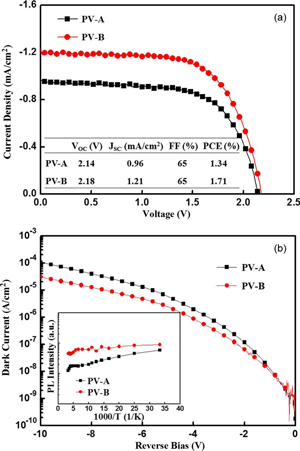- News
25 March 2011
Improving PV material quality with patterned sapphire
Researchers in Taiwan have been using patterned sapphire substrates to improve the performance of nitride semiconductor solar cells [C.C. Yang et al, IEEE Electron Device Letters, published online 24 February 2011]. The team was based at National Cheng Kung University, National Chiao Tung University, and Southern Taiwan University.
While patterned sapphire substrates are mainly used in light-emitting devices to increase light output by reducing the reflection at the air interface, here the patterning is used to improve the material quality of the nitride semiconductor. The improvement comes from reducing the area from which the nitride semiconductor crystal is seeded in a similar manner to that of epitaxial lateral overgrowth (ELOG) techniques. The aim is to reduce the threading dislocations that can act as paths for leakage current, reducing conversion efficiency.
The researchers used flat and patterned sapphire substrates on which layers of nitride semiconductor were deposited using metal-organic chemical vapor deposition (MOCVD). The patterned substrates had truncated cone structures created using photolithography and etch. The cones were put in a triangular array with 1.5μm spacing between cones (Figure 1). The cones were 1.5μm high, with top and bottom diameters of 1.0μm and 3.0μm, respectively.

Figure 1: Typical 45°-tilt scanning-electron-microscope images of (a) the surface morphology of truncated-cone patterns on sapphire substrates, (b) u-GaN under 500 torr, and (c) the coalesced quasi-2D growth of u-GaN.
The nitride growth began with a thin undoped GaN nucleation low-temperature layer, followed by 4μm of u-GaN. The process was controlled to achieve coalescence over the cones and a smooth surface.
The p-i-n structure of the photovoltaic device was begun with 1μm silicon-doped n+-GaN; continued with a short-period superlattice of 14 pairs of undoped Al0.14Ga0.86N/In0.21Ga0.79N (3nm/4nm); finishing with 0.1μm of magnesium-doped p-GaN.
Silicon dioxide was applied on top of the whole epilayer sequence as an anti-reflective layer. The PV devices measured 1mm x 1mm with 11.4% electrode coverage.
The performance of the PV cell on patterned substrate (PV-B) was enhanced relative to a device grown on a flat substrate (PV-A): at illumination of global 1.5 air-mass (AM1.5G), the short-circuit current was 26% higher and the open-circuit voltage was 2% higher (Figure 2). The conversion efficiency of the patterned device was 1.71%, compared with 1.34% for the flat cell. A conversion efficiency of 2.95% for nitride-based PV cells was achieved by Texas Tech University researchers last year (Texas Tech ‘significantly’ improves InGaN solar cell performance).
 Photoluminescence studies on the Taiwan epitaxial material showed a slightly red-shifted peak for the patterned epitaxial material at a ‘blue’ photon energy of 2.780eV (446nm), compared with 2.793eV (444nm), due to compressive strain in the non-flat material.
Photoluminescence studies on the Taiwan epitaxial material showed a slightly red-shifted peak for the patterned epitaxial material at a ‘blue’ photon energy of 2.780eV (446nm), compared with 2.793eV (444nm), due to compressive strain in the non-flat material.
Figure 2: (a) Typical current density vs voltage (J–V) characteristics of devices taken from PV cells illuminated under AM1.5G spectrum. Inset: measured PV parameters. (b) The measured dark current density with the reverse bias. Inset: Arrhenius plots of integrated photoluminescence intensities for PV-A (flat) and PV-B (patterned).
The researchers warn: “Although this red-shift could be beneficial for broader solar-spectrum absorption, it should be carefully considered because the excess strain would eventually relax, generating additional threading dislocations to result in leakage paths in the PV devices.”
In the present case, the slightly longer wavelength did make the patterned device more sensitive to the solar spectrum. The researchers estimated that this factor would give the patterned device a 10% current boost over the flat cell. As seen above, the actual figure was 26%, showing that improved material quality must also play a role.
Nitride solar cell achieves peak EQE of 72%
Superlattice nitride solar cells achieve higher conversion
Free-standing GaN substrate improves nitride solar cell performance
Texas Tech ‘significantly’ improves InGaN solar cell performance
Nitride solar cell Patterned sapphire substrates MOCVD
The author Mike Cooke is a freelance technology journalist who has worked in the semiconductor and advanced technology sectors since 1997.
Join Semiconductor Today's LinkedIn networking and discussion group
